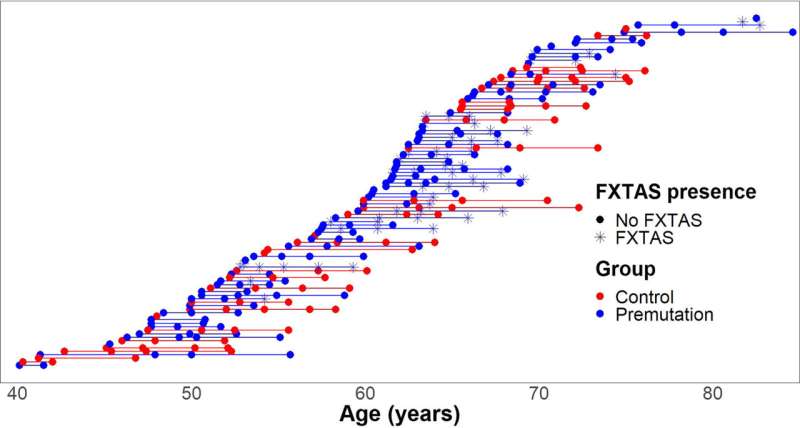This article has been reviewed according to Science X's editorial process and policies. Editors have highlighted the following attributes while ensuring the content's credibility:
fact-checked
trusted source
proofread
Loss of executive function may signal onset of neurodegenerative condition FXTAS

New UC Davis research shows that men with an FMR1 premutation who experienced reduced executive function were at higher likelihood of developing fragile X-associated tremor/ataxia syndrome (FXTAS).
FXTAS is a progressive genetic condition that causes movement issues and cognitive decline. These findings, published in the journal Movement Disorders, could help clinicians determine which premutation carriers will eventually develop FXTAS.
"There's converging evidence that the premutation is affecting certain circuits in the brain before any movement problems show up on a clinical exam," said the UC Davis MIND Institute's David Hessl, a professor in the Department of Psychiatry and Behavioral Sciences, and the first author on the paper. "We're getting closer to identifying the carriers who are most likely to develop full-blown FXTAS. If we could intervene early, we might be able to prevent it or slow it down significantly."
Patients with FXTAS, which was first identified at the MIND Institute in 2001, experience cognitive decline and Parkinson's disease-like movement issues. However, many people with FMR1 premutations do not go on to develop the disease. Hessl and colleagues have been investigating markers that might indicate which FMR1 carriers are at highest risk.
Executive function as a marker
For many years, the MIND Institute has been studying people with FMR1 variations to better understand the natural history of FXTAS. In this most recent study, the team followed 66 people with FMR1 premutations, and 31 controls, for up to nine years. During follow-up visits, participants and their partners completed executive function inventories and other assessments to measure the carriers' function.
"Executive function refers to the cognitive abilities that help us organize our behavior: to resist impulses, be patient and not jump into things too quickly," Hessl said. "They also regulate our attention and working memory, so holding information in our mind while we're doing something else. For example, remembering where you put your phone after you've gone on to do something else."
When the study started, premutation carriers' executive function was similar to controls. But over time, a significant number of FMR1 carriers developed executive function challenges. Overall, the results showed that carriers who experienced problems with working memory, organization, task monitoring and other traits were more likely to develop FXTAS.
"It's one of the earliest indicators we've been able to identify that has some predictive value for who would develop FXTAS later," Hessl said. "We don't have enough data to know how strong of a predictor it is, but it did significantly associate with later conversion, which was eye-opening."
The authors caution that this is just one step in a long journey to develop precise clinical tools to identify which patients will develop FXTAS. While the findings in this study were statistically significant, they do not indicate the marker's clinical precision.
"It doesn't tell us whether a patient with X amount of executive function change has double the risk, five times the risk, or 10 times," Hessl explained. "We don't yet know how strong these predictors are, and we want to build models that will tell us that."
Still, this new understanding could help clinicians better monitor their FMR1 carriers. And while there are no current FXTAS treatments, there are drugs being tested, and monitoring executive function could be useful in determining their efficacy.
"We're looking at a number of different markers associated with disease progression," Hessl explained. "These include behavioral issues, like executive function, molecular biomarkers and data from brain MRIs. We believe there may be combinations of risk factors that could be examined in concert. There may be emerging machine learning and other statistical approaches that could combine these and help us achieve much better predictions, tell us who is at higher risk, or even identify protective factors."
More information: David Hessl et al, FMR1 Carriers Report Executive Function Changes Prior to Fragile X‐Associated Tremor/Ataxia Syndrome: A Longitudinal Study, Movement Disorders (2023). DOI: 10.1002/mds.29695




















